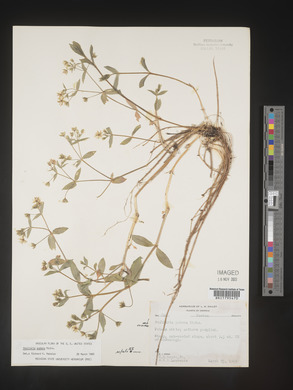Stellaria pubera
|
|
|
|
Family: Caryophyllaceae
Great Chickweed
|
Plants perennial, with stems loosely tufted, rhizomatous. Stems erect, branched, 4-sided, 10-40 cm, with alternating lines of spreading, soft, flexuous, mainly eglandular hairs. Leaves usually sessile (distal), often short-petiolate (proximal); blade elliptic, obovate, or lanceolate, widest at or beyond middle, 1-10 cm × 5-35 mm, base cuneate, margins entire, apex acute, glabrous to sparsely pubescent adaxially, ciliate on margins and abaxial midrib. Inflorescences terminal, 3-70-flowered cymes; bracts elliptic to lanceolate, 7-65 mm, herbaceous. Pedicels erect in flower, often deflexed at base in fruit, 5-40 mm, softly pubescent. Flowers (8-)10-12 mm diam.; sepals 5, with midrib, ovate, 3.5-6 mm, margins narrow, scarious, apex obtuse to acute, softly and often sparsely pubescent; petals 5, 4-8 mm, longer than sepals; stamens 10; styles 3, ascending, 2.5 mm. Capsules green to straw colored, broadly ovoid, 3.5-5.5 mm, ca. equaling sepals, apex obtuse, opening by 6 valves; carpophore absent. Seeds brown, obliquely reniform, 1.5-2 mm diam., coarsely sulcate-papillate. 2n = 30. Flowering spring. Rich deciduous woods, alluvial bottomlands; 100-1000 m; Ala., D.C., Fla., Ga., Ind., Ky., Md., Nebr., N.C., Ohio, Pa., S.C., Tenn., Va., W.Va. Stellaria pubera has been introduced in Nebraska and possibly in Illinois. It is very similar to S. corei but is distinguished by its shorter, more ovate sepals.
Perennial herb with rhizomes 10 - 40 cm tall Stem: upright or ascending, loosely tufted, branched, four-angled, with alternating lines of soft, spreading hairs. Leaves: opposite, short-stalked (lower), stalkless (upper), 1 - 10 cm long, 5 mm - 3.5 cm wide, elliptic or egg-shaped or lance-shaped with a tapering base and pointed tip, widest near or at the middle, one-veined, sometimes sparsely hairy, with hairs along the margins and midrib. Inflorescence: a terminal, leafy, open cluster (cyme) of three to seventy flowers, subtended by a pair of bracts. Bracts 7 mm - 6.5 cm long, elliptic to lance-shaped, herbaceous. Flowers: white, 1 - 1.2 cm wide. Stalk upright, 5 mm - 4 cm long, softly hairy. Stamens ten. Styles three. Sepals: five, distinct, green, 3.5 - 6 mm long, egg-shaped with a blunt to pointed tip, scarious-margined (dry, thin, and membranous), sparsely soft-hairy. Petals: five, white, 4 - 8 mm long, longer than sepals, deeply two-lobed (giving the appearance of ten petals). Fruit: a dehiscent capsule, opening by six valves, green to straw-colored, 3.5 - 5.5 mm long, about equal to the sepals, broadly egg-shaped with a blunt apex. Seeds brown, 1.5 - 2 mm wide, obliquely kidney-shaped, laterally compressed, coarsely grooved-bumpy. Similar species: The variety sylvatica differs by having longer, narrowly triangular to lance-shaped sepals. Flowering: March to May Habitat and ecology: Rare in the Chicago Region. Has been found on limestone bluffs in rich woods. Occurence in the Chicago region: native Etymology: Stellaria comes from the Latin words stella, meaning star, and -aria meaning "pertaining to," referring to the shape of the flowers. Pubera means hairy. Author: The Morton Arboretum Erect or ascending perennial 1.5-4 dm, thinly spreading-hairy, the stem often pubescent in 1 or 2 lines; early floriferous shoots followed by taller, more vigorous, chiefly vegetative ones; lvs elliptic to lanceolate or oblanceolate or ovate, 2-9 נ1-3 cm, acute; fls in leafy, open, terminal cymes; pedicels 1-3 cm; pet and the ovoid fr shorter than the sep; seeds 1.7-2 mm, asymmetrically reniform, coarsely sulcate-papillate. Woods; N.J. to Ill., s. to Fla. and Ala. Apr.-June. Var. pubera (2n=30), with all but the lowermost lvs sessile, and with obtuse to acute sep mostly 4-6 mm that are usually puberulent on the back, occurs mainly in and e. of the Appalachian Mts., but may be found anywhere in the range of the sp. as a whole. Var. silvatica (Bꧮ) Weath. (2n=60), with the middle and lower lvs narrowed to a winged petiole 1-2 cm, and with the lance-acuminate sep 7-10 mm and glabrous except for the ciliate margins, occurs chiefly in and w. of the Appalachian Mts. If the var. silvatica is treated as a distinct sp. it apparently takes the name S. corei Shinners. S. silvatica (Bꧮ) Maguire is preoccupied, and Alsine tennesseensis properly applies to a form of var. pubera instead of var. silvatica. Gleason, Henry A. & Cronquist, Arthur J. 1991. Manual of vascular plants of northeastern United States and adjacent Canada. lxxv + 910 pp. ©The New York Botanical Garden. All rights reserved. Used by permission. From Flora of Indiana (1940) by Charles C. Deam Infrequent to frequent in the southern counties, becoming very rare in the northern part of its range in the state. Since this species is confused with Stellaria media, I am referring the report from Steuben County to that species. It is, no doubt, found slightly farther north than our map indicates but there are no reports from Michigan or northern Ohio. It prefers a deep leaf mold and is found in moist soil on wooded slopes and in the bottoms of ravines. It is strictly a woodland species. …… Indiana Coefficient of Conservatism: C = 7 Wetland Indicator Status: N/A |
|
|
|


















































































